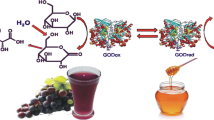Abstract
A sensor for ethanol is described that is based on the fluorescent probe 5,10,15,20-tetraphenyl porphyrin (TPP). Response is based on the quenching of the fluorescence of TPP by ethanol as a result of electrostatic attraction. The sensor linearly responds to ethanol in the concentration range from 1 to 75 vol.% and was applied to the determination of ethanol in various kinds of wines and whisky.


Similar content being viewed by others
References
Nephew TM, Williams GD, Yi H, Hoy AK, Stinson FS, Dufour M, Surveillance Report #59: Apparent Per Capita Alcohol Consumption: National, State, and Regional Trends, 1977–2000, Alcohol Epidemiologic Data system, NIAAA, Division of Biometry and Epidemiology, Rockville, MD, September 2003
Lakins NE, Williams GD, Yi H, Smothers BA, Surveillance Report #66: Apparent Per Capita Alcohol Consumption: National, State, and Regional Trends, 1977–2002. NIAAA, Division of Epidemiology and Prevention Research, Alcohol Epidemiologic Data System, August 2004
AOAC (1990) Official Methods of Analysis of the Association of Analytical Chemistry, Washington, DC
Amerine MA (1972) Uniform Methods of Analysis for Wine and Spirits, Davis
Amerine MA, Ough CS (1974) Wine and Must Analysis. Willy, NY
Ough CS, Amerine MA (1988) Methods for Analysis of Musts and Wines, 2nd ed. Wiley-Interscience, NY
Calull M, Lopez E, Marce RM, Olucha JC, Borrull F (1992) Determination of carboxylic acids, sugars, glycerol and ethanol in wine and grape must by ion-exchange high-performance liquid chromatography with refractive index detection. J Chromatogr 590:215–222
Wolfbeis OS, Posch HE, Fresenius Z (1988) A Fibre Optic Ethanol Biosensor. Anal Chem 332:255–257
Zeng HH, Wang KM, Li D, Yu RQ (1994) Development of an alcohol optode membrane based on fluorescence enhancement of fluorescein derivatives. Talanta 41:969–975
Seiler K, Wang K, Kuratli M, Simon W (1991) Development of an ethanol-selective optode membrane based on a reversible chemical recognition process. Anal Chim Acta 244:151–160
Spichiger UE, Kuratli M, Simon W (1992) ETH 6022: an artificial enzyme? A comparison between enzymatic and chemical recognition for sensing ethanol. Biosens Bioelectr 7:715–723
Mohr GJ, Citterio D, Spichiger-Keller UE (1998) Development of chromogenic reactands for optical sensing of alcohols. Sens Actuators B 49:226–234
Mohr GJ, Citterio D, Demuth C, Fehlmann M, Jenny L, Lohse C, Moradian A, Nezel T, Rothmaier M, Spichiger UE (1999) Reversible chemical reactions as the basis for optical sensors used to detect amines, alcohols and humidity. J Mater Chem 9:2259–2264
Isha A, Yusof NA, Ahmad M, Suhendra D, Md Zin Wan Yunus W, Zainal Z (2007) Optical fibre chemical sensor for trace vanadium(V) determination based on newly synthesized palm based fatty hydroxamic acid immobilized in polyvinyl chloride membrane. Spectrochim Acta A 67:1398–1402
Wang X, Zeng H, Zhao L, Lin JM (2006) A selective optical chemical sensor for 2,6-dinitrophenol based on fluorescence quenching of a novel functional polymer. Talanta 70:160–168
Paolosse R, Natale C, Burgio M, Martinelli E, Mazzone E, Palleschi G, D’amico A (2003) Porphyrin-based array of cross-selective electrodes for analysis of liquid samples. Sens Actuators B 95:400–405
Long GL, Winefordner JD (1983) Limit of detection. Anal Chem 55: A712–&
Rotariu L, Bala C, Magearu V (2004) New potentiometric microbial biosensor for ethanol determination in alcoholic beverages. Anal Chim Acta 513:119–123
Matsumoto K, Matsubara H, Hamada M, Ukeda H, Osajima Y (1990) Simultaneous determination of glucose, ethanol and lactate in alcoholic beverages and serum by amperometric flow injection analysis with immobilized enzyme reactors. J Biotechnol 14:115–26
Simon DN, Czolk R, Ache HJ (1995) Doped sol-gel films for the development of optochemical ethanol sensors. Thin Solid Films 260:107–110
Paixao TRLC, Corbo P, Bertotti M (2002) Amperometric determination of ethanol in beverages at copper electrodes in alkaline medium. Anal Chim Acta 472:123–131
Santos AS, Freire RS, Kubota LT (2003) Highly stable amperometric biosensor for ethanol based on Meldola’s blue adsorbed on silica gel modified with niobium oxide. J Electro Anal Chem 547:135–142
Mohr GJ, Lehmann F, Grummt UW, Spichiger-Keller UE (1997) Fluorescent ligands for-optical sensing of alcohols: Synthesis and characterisation of p-N,N-dialkylamino- trifluoroacetylstilbenes. Anal Chim Acta 344:215–225
Author information
Authors and Affiliations
Corresponding author
Electronic supplementary material
Below is the link to the electronic supplementary material.
Table S1
Recovery of ethanol from spiked beverages (DOC 41 kb)
Rights and permissions
About this article
Cite this article
Bozkurt, S.S., Merdivan, E. & Benibol, Y. A fluorescent chemical sensor for ethanol determination in alcoholic beverages. Microchim Acta 168, 141–145 (2010). https://doi.org/10.1007/s00604-009-0271-y
Received:
Accepted:
Published:
Issue Date:
DOI: https://doi.org/10.1007/s00604-009-0271-y




